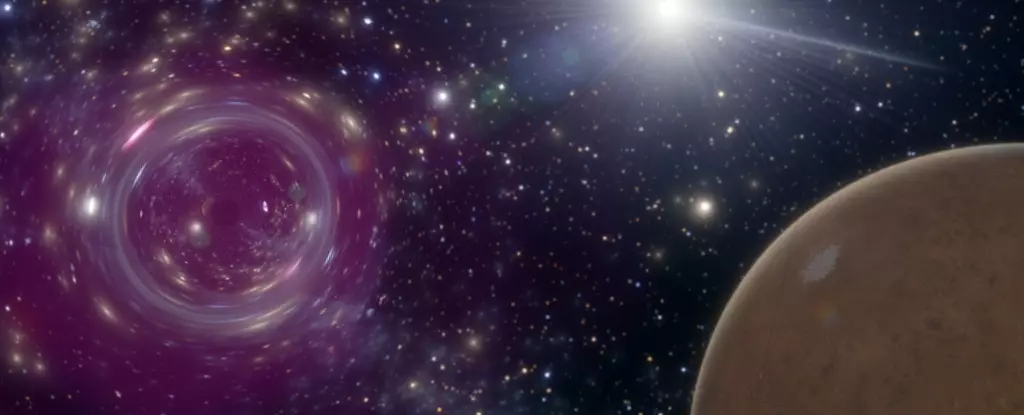In the vast expanse of our universe, the existence of primordial black holes (PBHs) has long tantalized scientists, holding the promise of unlocking secrets about dark matter and the conditions that followed the Big Bang. A recent study indicates that these tiny, ancient black holes could pass through our Solar System, potentially influencing the orbits of celestial bodies like Mars. This novel research not only deepens our understanding of dark matter but invites us to ponder the hidden phenomena of our cosmic neighborhood.
Primordial black holes are theorized to have formed within the first moments of the universe’s inception—fractions of a second after the Big Bang—when regions of densely packed ionized matter collapsed under their own gravitational pull. Unlike their larger counterparts that evolve from dying stars, PBHs would be significantly smaller, with some estimates suggesting a mass akin to that of an asteroid, crammed into the expanse of a single atom. Hence, they exist unseen throughout the universe, sharing the cosmos subtly but profoundly with ordinary matter.
As scientists continue to search for dark matter, which remains one of the most elusive aspects of astrophysics, primordial black holes have emerged as a prime candidate. They might constitute a substantial portion of dark matter, contributing gravitational effects that influence visible celestial structures.
The intriguing possibility arises that these primordial black holes could pass through our Solar System, presenting opportunities to observe their effects. Calculations suggest that a PBH with an asteroid’s mass could traverse the inner Solar System approximately every decade, although direct visibility is impossible due to their invisibility. However, their presence could trigger a detectable wobble in the orbit of Mars, prompting scientists to seek out these cosmic visitors.
Specifically, the study revealed that if a primordial black hole were to come within a distance of around 450 million kilometers (approximately 280 million miles) from Mars, it could induce a distortion in the red planet’s orbit, manifested as a shift of about one meter over a decade. This minor deviation might seem insignificant but is well within the measurement capabilities of our modern observational technologies.
What if a primordial black hole were to come alarmingly close to an individual? Lead researcher Tung Tran from the Massachusetts Institute of Technology (MIT) explored this hypothetical scenario, estimating that someone within one meter of such an object would be violently displaced up to six meters in just one second. While such close encounters are extremely rare, the team shifted focus from individual interactions to the broader implications of PBHs on planetary systems.
They conducted simulations of PBH interactions with planets, notably Mercury, Venus, and Mars. Among these, Mars provided the most pronounced signal, largely because it is currently under heavy observational scrutiny. Initially, researchers pondered whether the gravitational influence of space rocks, which frequently traverse our solar neighborhood, would yield similar effects. The answer is nuanced; while asteroids do exert gravitational forces, their slower velocities and longer orbital periods render their interactions less distinct compared to the rapid passage of primordial black holes.
This inquiry raised an essential query about distinguishing the gravitational influences of PBHs from those of regular asteroids and other celestial bodies. Detailed simulations are paramount to grasp the dynamics associated with PBH interactions. As MIT physicist David Kaiser noted, understanding the expected background, including the typical speeds and distributions of asteroids, contrasts with the swift transit of PBHs.
The goal is to refine our understanding and predictability of the gravitational effects caused by such primordial objects, allowing astronomers to identify genuinely extraordinary events against the normal backdrop of celestial motion.
With ongoing developments in observational science, researchers hope to identify these elusive primordial black holes by their subtle effects on Martian orbit. The study of PBHs does not merely lend insight into potential dark matter candidates but could illuminate broader questions regarding the evolution of the universe itself. Each detection carries the weight of significant cosmological implications, bringing us closer to comprehending the very fabric of our universe.
The quest to explore these ancient remnants of the cosmos emphasizes the interconnectedness of theoretical physics, simulation modeling, and observational astronomy. As we continue to venture deeper into the mysteries of dark matter, celestial interactions, and the nature of primordial black holes, the universe continues to present us with profound enigmas waiting to be unraveled.


Leave a Reply